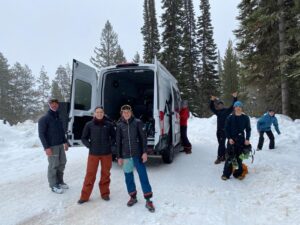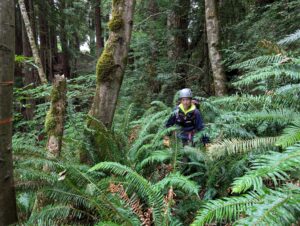Kate Patterson’s first SAR mission was the kind that search and rescue volunteers always hope for. A 71-year-old woman had been missing in remote Mendocino County, Calif., for several days. The terrain was steep and heavily vegetated. Overnight temperatures dipped down into the 40s for the two nights she was out. Patterson, a member of Marin County (Calif.) Search and Rescue, responded as part of a large mutual aid request and was on a team assigned to a long drainage in the search area.
Clues were discovered that led to finding the woman, who was tired but alive and well. Patterson was in the the command post when the woman was reunited with her family and the woman’s son thanked her. “It gave me a different perspective on life,’’ the 16-year-old high school junior said. “It was so great to see what an impact we made.”
Indeed, most SAR volunteers would agree the work is rewarding, but few can say they got to experience that when they were teenagers. Youth members are not common on Mountain Rescue Teams, though there are more programs affiliated with SAR teams around the country. Teams that have youth programs speak highly of what the younger members bring to the team as a whole, and the youth themselves, usually high school students, love the experiences they get in leadership, responsibility and being a trusted teammate. For some, it changes the trajectory of their life, spurring them to careers in medicine, the fire service or the outdoors.
Michael Yuan, 28, remembers the moment SAR changed his life. He was a high school student interested in engineering and relatively new to Marin’s team in 2012, when he was part of a team that found an injured person in Monterey County. He had just completed the Emergency Medical Responder class and helped with the transfer of care to a CalStar medical flight crew. “I remember seeing the flight nurse and thinking, that’s it. That’s what I want to do,” Yuan said. Yuan made good on that, going to college for nursing, working on ambulances and in the emergency room and the ICU, and most recently taking a job with REACH Air Medical Services as a flight nurse. He is still an active member of the Marin team and oversees medical trainings.
Marin SAR, which is also a Boy Scout Explorer Post, has about 40 active youth members, of a total of about 150 SAR volunteers. Marin SAR Unit Leader Michael St. John was 16 when he joined the team 45 years ago and he is a huge proponent of the program. St. John is a passionate advocate for youth, often putting them into leadership roles and pushing them to learn new skills or take on more responsibilities.
“It’s very hard for young adults to acquire outdoor skills. SAR offers a unique forum to teach a broad base of important skills like leadership and responsibility,” St. John said. Youth members are able to do everything that adult members do, from leading trainings to serving as team leaders in the field. “Well-trained high-school aged members are excellent searchers,” St. John said, noting they have less bias, more energy and can often see and hear better.
Adult volunteers also value their experience with youth, citing the opportunity to work with young people as a sometimes unexpected bonus. Whether it’s learning new technology from a teenager or building complex rope systems alongside them, adult volunteers say they get as much out of working with youth as the youth get from being given the opportunity for leadership and service.
“Youth bring a level of enthusiasm and joy that is very valuable to the team,” said Matt Shargel, a volunteer with Contra Costa County (Calif.) Search and Rescue for 19 years who also has four sons who have been cadets on the team. Shargel is impressed with the youth and the dedication of the team to the youth’s development. He especially loves the camaraderie he gets with his sons when a call comes in and they can all grab uniforms and gear and head out the door. “I have a heart for service and they do too, so to get to do that together has just been great,” Shargel said.
Contra Costa has had a youth program since 1976, when it started with a Boy Scout Explorer Post, said Walter Eichinger, Captain of the Contra Costa team. “It took off like wildfire” after it was started, he said, with 30 to 40 youth on the team for the first 20 years or so. Today, the team has about 25-30 youth cadets who have the same application and interview process as adults, and also complete the same entry-level academy with fitness tests.
“I love the way the team operates,” said Hannah Zuroff, who was the Cadet Captain and joined Contra Costa SAR in 2022 when she was 16. “ It’s great getting to see the cadets grow confident and work with adults building professional relationships.”
Teton County (Colo.) SAR has a smaller youth program with about 12 high school aged members, said Michael Estes, SAR coordinator for TCSAR. TCSAR youth are part of a Boy Scouts Venture Crew and are eligible to attend all team trainings and have to have much of the same qualifications like ICS classes and patient packaging, Estes said. “They are learning all the stuff the team is,” said Estes, who has been on TCSAR since 1993.
Evelyn Klein, 18, is the president of the TCSAR Venture Crew and a senior in high school. She joined SAR when she was 16 and was the only active girl at that time. As the president, Klein and the other Venture crew members can also design their own trainings and decide what they want to learn. A recent youth training focused on avalanche training and rescue scenarios up on Teton Pass, she said.
Marin and Contra Costa are somewhat unique in the MRA because their youth are not restricted in what they can do, with the exception of driving vehicles, which usually requires volunteers be at least 18 years old. Marin allows youth members to miss school for missions, but Contra Costa does not, teams said. Teton SAR doesn’t usually use youth on missions, Estes said.
Safety is a big issue that teams are very conscious of, and there are policies and procedures in place to ensure that youth are properly trained and supervised, teams said.
Marin follows Boy Scout Youth Protection guidelines and trains all members on workplace safety and anti-harassment. Overnight deployments or trainings are carefully supervised, always with more than one adult present. Contra Costa gets parent permission before deploying youth on out-of-county missions and assigns an adult buddy to be with the cadet.
One thing all the teams grapple with is recoveries and finds of deceased persons. Teton does’t bring youth members to most rescues because of the possibility of finding a body. “It’s not something we want to expose a student to,” Estes said. Marin limits the number of members who respond to the scene when a deceased person is found, but its youth have been on find teams. The team has a peer support team that reaches out to everyone on a find team, and parents are always apprised of the situation, St. John said.
Other SAR teams around the country that are not part of the MRA also have youth programs. Many started as Boy Scout groups of some kind, though most have left that affiliation behind.
Arapahoe Rescue Patrol in Littleton, Colo., is a SAR team comprised completely of youth members, established in 1957. ARP has about 65 members and was recently in the news when the team assisted in a search for a missing Boulder County man and located him deceased about a half a mile from his home.
Multnomah County (Ore.) Sheriff’s Office Search and Rescue team has about 100 active members, both youth and adult. The team’s origins go back to a Boy Scout Explorer Post established in 1944, but search and rescue didn’t become a primary focus until the early 1960s after the Post assisted in the search for a missing boy on Mt. Hood, according to the team’s website.
Mendocino County SAR Commander Jared Chaney has seen first hand how empowering youth makes for better teams and better members. “I saw a huge increase in the quality of my youth when I stopped treating them differently,” he said of changes he made to his team’s youth program when he became the unit’s leader in 2016. “They were better because we trusted them to do an adult searcher’s job.”
Marin’s Patterson and other youth members agreed that the trust they are afforded builds their confidence and helps them learn life skills. “People think young people are not as capable and I think this program proves that wrong,” Patterson said.





